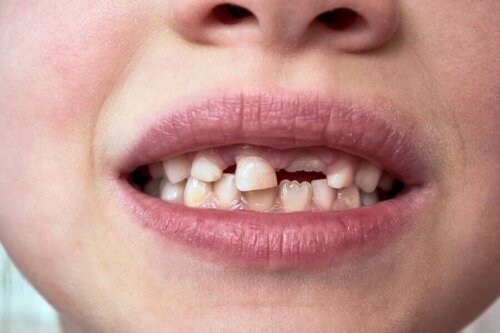All You Need to Know about Baby Teeth

Milk teeth arrive near the beginning of human childhood. They’re also known as temporary teeth, or milk teeth, because over time they’re replaced by permanent teeth. The second name comes from the fact that their appearance runs alongside the lactation stage. We’ll now tell you all you need to know about baby teeth.
Humans have a total of 20 baby teeth. There are 10 at the top and 10 at the bottom. They’re made up of four incisor teeth, two canines or fangs and four molars in each arch. Each child is different when it comes to teeth falling out.
The birth of baby teeth is a very important milestone in human development. They allow chewing and, therefore, make different dietary choices possible. Also, they act as support for the child’s speech. They also keep space for permanent teeth to come through.
Discover more: Taking Care of Your Teeth in the Summer
All you need to know about baby teeth
What usually happens is that the first teeth begin to emerge between the fifth and eighth month of life. The first to appear are the lower incisors. The process is uncomfortable and painful for the child, who can be irritable and lose their appetite.
It’s very common for babies to search for objects to chew on during this process to relieve pain. The best thing to give them is teethers to relieve their cravings without damaging the gums. It’s also common for them to have some fever and redness in the gums.
The most critical moment is when the first teeth are just about to emerge. This is when the pain increases and the gums become more inflamed and redder. When the teeth are about to emerge, a whitish coloration appears.
In most cases, baby teeth finish developing after around 3 years. This can vary from child to child, and it doesn’t mean there’s anything to worry about. Some children complete teething by 2 years old and others do so by 4.
The importance of the first teeth
As we discussed in the introduction, baby teeth are essential for chewing and speaking. Not only that, they reserve space for permanent teeth to come through without any problems. These adult teeth are already growing under the gums and need a suitable place to emerge in due course.
When a baby tooth is lost too quickly, the permanent teeth can emerge too early. This leads to other teeth not having the necessary space to come through and results in a denture with several crooked teeth.
Hygiene and care for baby teeth

You should wash your baby’s mouth from the beginning of their first days of life. You can do this with a clean, damp cloth or gauze. Immediately after their first teeth appear, brushing is essential. Cavities can emerge even shortly after the first baby teeth appear.
The best thing to do is brush your child’s teeth in the morning and at night, with a small amount of fluoridated toothpaste That amount should increase for 3- to 6-year-olds, but it should never be more than the size of a pea. This is also a great way to make teeth brushing a habit.
Discover more: 9 Natural and Effective Tips for Taking Care of Your Teeth
Teeth loss
Most often, you start to lose baby teeth at around 6 years old. The first to loosen are the front incisors. This is because permanent teeth cause the roots of the baby teeth to be absorbed and held by only a small portion of tissue.
Bit by bit, the other teeth fall out. The last to fall are the posterior molars, at around 10 or 12 years old. By the time your child is 13, they will probably have most of their permanent teeth.
If baby teeth don’t loosen naturally, your dentist may recommend extraction. Premature loss of baby teeth is the cause of 30% of orthodontic problems.
All cited sources were thoroughly reviewed by our team to ensure their quality, reliability, currency, and validity. The bibliography of this article was considered reliable and of academic or scientific accuracy.
- Cupé-Araujo, A. C., & García-Rupaya, C. R. (2015). Conocimientos de los padres sobre la salud bucal de niños preescolares: desarrollo y validación de un instrumento. Revista Estomatológica Herediana, 25(2), 112-121.
- Lorenzo Moriano, B., Elena Sánchez, M. V., & Valero Juan, L. F. (2008). Evaluación de la salud bucodental y estilos de vida saludables en la población infantil que acude a la consulta odontológica de atención primaria. Odontología Preventiva.
- Pérdida prematura de dientes primarios y su relación con la edad y el sexo en preescolares. (2007). Revista Odontológica de Los Andes.
This text is provided for informational purposes only and does not replace consultation with a professional. If in doubt, consult your specialist.








